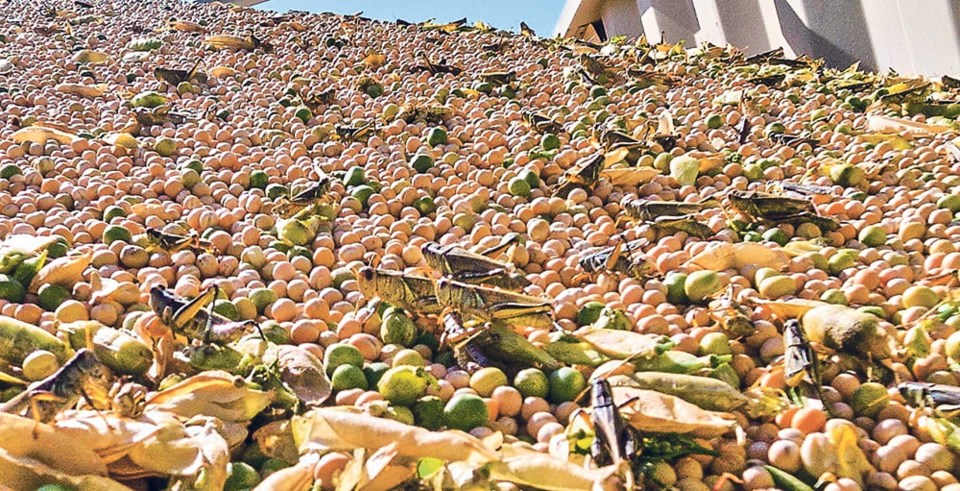SWIFT CURRENT, Sask. — Organic growers may have decisions to make after grasshoppers chomped their way through prairie fields this summer.
A survey of 51 Saskatchewan organic farmers found they all expect production and financial losses because of grasshopper damage, and the destruction is greater than last year.
“The grasshoppers of 2023 may be the final nail in the coffin of my organic farming career,” said one survey respondent.
Although the survey represents a small sample of farmers, losing any organic farmers is significant.
SaskOrganics executive director Marla Carlson, who presented the results at an organic and low-input field day, said the concern is about what lies ahead.
“The number who have actually dropped (organic certification) is small for now, which is heartening. What is going to be the last straw?” she said.
Two respondents said they had already dropped organic certification on some land, and one had given it up completely.
But 12 more were considering reducing their certified acres on some land, and five on all their organic land.
Most of the responses came from southwestern and west-central Saskatchewan. The most prevalent farm size was less than 2,500 acres, at 55 percent.
Most respondents reported crop loss of less than 10 percent last year but expect greater losses in 2023. Sixty-five percent said losses will be larger than 10 percent; 41 percent expect losses between 11 and 50 percent.
Farmers also said this will make more acreage vulnerable to wind and water erosion.
Nearly three-quarters of the respondents have crop insurance. About 65 percent are likely to file claims this year compared to 32 percent last year.
Even with crop insurance payouts, the respondents said they expect financial losses greater than 2022. The largest category, 37 percent, say they will lose less than $10,000, but 27 percent project losses between $30,000 and $90,000, and 10 percent said losses would be more than $210,000.
Grasshopper control on organic land is limited. The survey found 22 percent of respondents had tried some form of allowed control.
“The Nolo bait was one that was quite popular and effective-ish, from what we heard, but unfortunately their factory burned down and they have no plan of rebuilding the factory, so accessing that solution is going to be problematic in Canada,” Carlson said.
Other options include sugar and molasses mixes, diatomaceous earth and soil solutions to increase BRIX levels. BRIX stands for balling relative intensity index, which is the sugar content of an aqueous solution. Plants with low BRIX levels are not getting enough nutrition from their roots.
Most of the survey respondents had seeded less susceptible crops such as peas, pea/oat mixtures, lentil/oat mixes and red millet.
Myriam Fernandez, who heads the organic research program at the Swift Current Research and Development Centre, said trials using sorghum, red millet, canaryseed and winter peas looked promising before a July 22 hail storm wiped out plots
“We will certainly try it again,” she said.
Farmers attending the field day offered their methods, such as seeding yellow peas around each cereal field to try to dissuade the grasshoppers. Many said peas provide protection, at least when the grasshoppers are young.
Dale Hicks from Mossbank, Sask., used to have certified land and is involved in the family seed business. He said peas work to a point and forage mixes that contain millet have been successful at keeping grasshoppers at bay.
“We noticed a few years ago when hoppers started moving in that they would nip at the millet when they were young but they wouldn’t devour it,” he said.
He said even gophers aren’t big fans.
Including millet in cereals can ensure that there is at least something to bale as greenfeed.
“On our commercial cereals that we have in rotation, I just started blowing in millet on the outside couple rounds and it turned out to be a good thing because as they chewed off the wheat, I still have some millet there,” he said.
Once the grasshoppers start to fly, however, all bets are off.
“I mean, they ate a pair of underwear hanging on the clothesline. Apples. They eat anything, but when they’re younger, you can hold them off with millet,” he told the meeting.
Sorghum provides similar benefits.
Hicks also said he has stayed ahead of grasshoppers by planting fall and winter crops in late October when moisture exists. Planting millet with winter wheat allows the greenfeed option.
University of Lethbridge grasshopper expert Dan Johnson said work on biocontrol options has been underway for a long time but problems with regulatory agencies, low efficacy, lack of industrial partnership and poor experimental design have combined to stymie those efforts.
Carlson said more research is required, as evidenced by comments in the survey.
“We need to get something that works approved. I am about to lose all my pulse crops this year due to grasshoppers,” said one respondent.
“Our wheat will be completely gone without a trace. They have moved into our lentils now and apparently eat off all the flowers. We will have zero crop. Dad will be selling most of his cows for lack of grazing and winter feed,” said another.
Add in weed pressure, drought, alfalfa weevil, lygus bugs and more, and organic producers have a lot to contend with this year.




